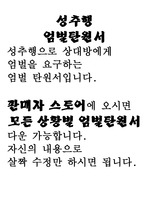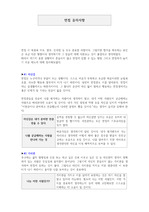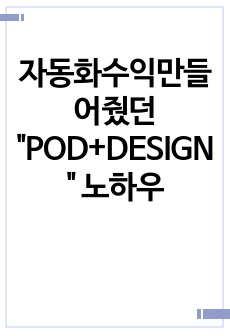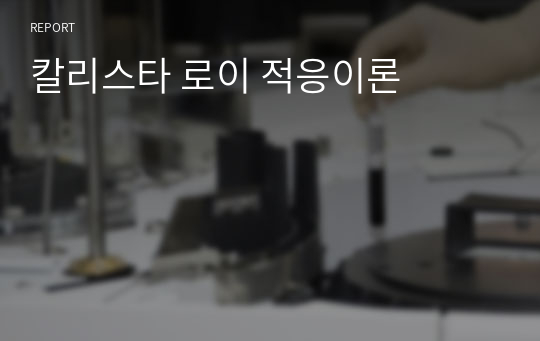소개글
"칼리스타 로이 적응이론"에 대한 내용입니다.목차
Ⅰ. 서론Ⅱ. 본론
1. 이론가의 개인적 배경
2. 이론발달의 이론적, 철학적 근거
1) 이론의 발달과정
2) 이론적 근거
3) 철학적 근거
Ⅲ. 이론소개
1. 가정
2. 주요개념 정의
3. 명제(proposition)
4. 적응이론이란?
5. 주요 구성요소
6. 간호의 메타패러다임
Ⅳ. 간호적용: 교육, 연구, 실무-행정
1. 교육
2. 연구
3. 실무
4. 행정
Ⅴ. Roy 이론을 적용한 국내 간호 연구
Ⅵ. 결론
Ⅶ. 참고문헌
본문내용
로이는 자신의 적응모형을 1964년부터 개발하기 시작하였으며 1970년에 처음 발표하였다.로이는 심리생리학자 헬슨(Helson 1964)의 이론으로부터 크게 영향을 받아 자신의 이론을 발전시켜 나갔으며, 헬슨의 이론과 라포포트(Rapoport)의 체계에 대한 정의를 통합하여 인간을 적응체계로 보았다. 모형 속의 생리적 욕구, 자아개념 및 역할기능 그리고 상호의존성 등은 인간에 대한 이해를 위해 사회적 상호작용론, 생물학, 행동과학에서 도출해 낸 것이다. 로이는 자신의 모형에 인간의 가치체계를 포함시켰으며, 그녀의 이론에 따르면 간호에 있어 인본주의란 “인간 자신의 창조력에 대한 믿음 또는 인간 자신의 대처능력이 안녕을 증진할 것이라는 믿음”이다. 로이 간호모형의 총체적 접근은 인본주의에 근거한 것이다.
초기의 로이의 모형은 개인의 적용에 있어서는 일반체계이론에 기반을 두고 있으며 자극의 종류에 대해서는 헬슨의 적응개념을 적용하였다. 1976년에 저서인 “간호에 관한 소개: 적응모형(Introduction to Nursing : An Adaptation Model)을 집필하였다. 초판이 출판된 후 적응개념이 간호교육, 실무 및 연구 분야에서 널리 사용되면서 계속적으로 보완되어 1984년에 제 2판이 발간되었다. 로이의 이론적 차원과 실무적용은 로이뿐만 아니라 동료도 참여하면서 개발되었다. “간호에 관한 소개: 적응 모형”은 모두 5부로 구성되어 있다. 제 1부는 간호 모형에 관한 서로 부분으로 모형의 주요 요소인 인간, 건강, 환경, 간호행위에 대해 기술하고 있다. 제2부에서 5부까지는 로이가 제시하고 있는 4개의 적응유형, 즉 생리적 유형, 심리 사회적 유형의 이론 발달 및 적용, 여러 집단이나 적용 유형에 따른 적응에 대해 세부 내용을 다루고 있다.
로이는 초기에 개발한 자신의 적응모형에다 최근 간호의 주요개념으로 분류되고 있는 인간, 건강, 환경, 간호 행위 및 목표의 개념을 연역-귀납적 분석을 통해 모형을 전개하고 있다.
본론에서는 로이의 개인적 배경과 이론적, 철학적 근거 , 적응이론의 가정, 명제, 개념을 살펴보고 간호에 적용된 사례들을 살펴보고자 한다.
참고 자료
강현숙 외 역(2008). 간호이론가와 이론. 대학서림.이경식 외 역(2001). 로이적응모형. 현문사.
이선옥, 김영임(2005). 간호이론. 한국방송대학교 출판부.
이소우 등(2000). 간호이론의 이해, 서울. 수문사.
장선옥(1994). Roy적응모델의 가족건강사정에의 적용가능성. 한국보건간호학회지, 8(2), 35-56.
조정호(1993). Roy의 적응모델에 의한 제왕절개술 산모의 간호진단 사례연구. 대한간호,32(3), 45-51.
김경옥, 조복희(2001) 뇌졸중 환자가 지각하는 사회적 지지와 희망과의 관계 .재활간호학회지,4(1).62
Ruby l. Wesley 저, 김명애, 고성희 공역(1995). 간호이론, 현문사
Brower, H. T., & Baker, B. J. (1976). The Roy adaptation model. Using the adaptation model in a practitioner curriculum. Nursing outlook, 24(11), 686-689.
Brydolf, M., & Segesten, K. (1996). Living with ulcerative colitis: experiences of adolescents and young adults. Journal of Advanced Nursing, 23(1), 39-47.
Camooso, C., Greene, M., & Reilly, P. (1981). Students' adaptation according to Roy. Nursing outlook, 29(2), 108.
Cannon, W. B. (1930). The autonomic nervous system. The Lancet.
Dickoff, J., James, P., & Wiedenbach, E. (1968). THEORY IN A PRACTICE DISCIPLINE: PART I. PRACTICE ORIENTED THEORY.
Dohrenwend, B. S., & Dohrenwend, B. P. (1969). Social Status And Psychological Disorder A Casual Inquiry. Nursing Reaserch, 17, 413-415.
Erickson, R. (1982). A model of adaptation to the thermal environment. Advances in Nursing Science, 4(4), 1-12.
Fawcett, J. (1989). Analysis and evaluation of conceptual models of nursing (2nd ed.). Philadelphia: Fa Davis.
Fawcett, J., Tulman, L., & PERRY SPEDDEN, J. A. N. E. (1994). Responses to vaginal birth after cesarean section. Journal of Obstetric, Gynecologic, & Neonatal Nursing, 23(3), 253-259.
Frank, D. I., & Lang, A. R. (1990). Disturbances in sexual role performance of chronic alcoholics : An analysis using Roy's adaptation model. Issuesin Mental Health Nursing, 11, 243-254.
Galligan, A. C. (1979). Using Roy's Concept of Adaptation to Care for Young Children. MCN: The American Journal of Maternal/Child Nursing, 4(1), 24-28.
Helson, H., Kahane, J. P., Katznelson, Y., & Rudin, W. (1959). The functions which operate on Fourier transforms. Acta Mathematica, 102(1-2), 135-157.
Helson, H. (1964). Adaptation-level theory: an experimental and systematic approach to behavior.
Hill, B. J. & Roberts, C.S. (1981). Formal theory construction: An example of the process. In C. Roberts & S.L. Roberts(Eds). Theory Construction in Nursing : An adaptation model. Englewood Cliffs N.J.: Prentice-Hall.
Lazarus, R. S. (1966). Psychological stress and the coping process.
Mastal, M. F., & Hammond, H. (1980). Analysis and expansion of the Roy adaptation model: a contribution to holistic nursing. Advances in Nursing Science, 2(4), 71-82.
Mechanic, D. (1962). The concept of illness behavior. Journal of chronic diseases, 15(2), 189-194.
Meleis, A. I. (1985). Theoretical Nursing: development and progress. AJN The American Journal of Nursing, 85(12), 1350.
Mitchell, G. J., & Pilkington, B. (1990). Theoretical approaches in nursing practice: A comparison of Roy and Parse. Nursing Science Quarterly, 3(2), 81-87.
Phillips, K. D., Moneyham, L., & Tavakoli, A. (2011). Development of an instrument to measure internalized stigma in those with HIV/AIDS. Issues in mental health nursing, 32(6), 359-366.
Pollock, S. E. (1993). Adaptation to chronic illness: A program of research for testing nursing theory. Nursing Science Quarterly, 6(2), 86-92.
Roy, C. (1970). Adaptation: a conceptual framework for nursing. Nursing Outlook, 18(3), 42-45.
Roy, C. (1971). Adaptation: basis for nursing practice. Nursing outlook, 19(4), 254-257.
Roy, C. (1973). Adaptation: Implications for curriculum change. Nursing outlook, 21(3), 163-168.
Roy, C. (1976). Introduction to nursing: An adaptation model. Prentice Hall.
Roy, C. (1979). Relating nuring theory to nursing education: A new era. Nurse Educator, 4, 16-21.
Roy, C. (1984). Introduction to Nursing: An Adaptation Model (2nd Eds). Englewood Cliffs N.J. : Prentice hall.
Roy, S. C. (1988). An explication of the philosophical assumptions of the Roy Adaptation Model. Nursing science quarterly, 1(1), 26-34.
Roy, C. (1989). The Roy adaptation model. In J. Rihel-Sisca(3rd Eds) Conceptual models for nursing practice. Norwalk Appleton & Langep, 105-148.
Roy, C. (1991). The Roy adaptation model: The definitive statement. McGraw-Hill/Appleton & Lange.
Roy, C. (1997). Future of the Roy model: Challenge to redefine adaptation. Nursing Science Quarterly, 10(1), 42-48.
Roy, S. C., & Andrews, H. A. (1991). The Roy Adaptation Model: The Definitive Statemente. Appleton & Lange.
Roy, C., & Anway, J. (1989). Roy's adaptation model: Theories for nursing administration. B. Henry, C. Amdt, M. DiV'1ncenti, & A Marriner-Tomey (Eds.), Dimension of nursing administration: theogg, researcl_1., education, practice, 75-88.
Roy, S. C., & Corliss, C. P. (1993). The Roy Adaptation Model: theoretical update and knowledge for practice. NLN publications, (15-2548), 215.
Roy, C., & McLeod, D. (1981). Theory of the person as an adaptive system. Theory construction in nursing: An adaptation model, 49-69.
Roy, C., & Roberts, S. L. (1981). Theory Construction in Nursing An Adaptation Model. Englewood cliffs N.J.: Prantice-hall.
Schmitz, M. (1980). The Roy adaptation model: Application in a community setting. Conceptual models for nursing practice, 193-206.
Selye, H. (1946). The general adaptation syndrome and the diseases of adaptation 1. The Journal of clinical endocrinology & metabolism, 6(2), 117-230.
Silva, M. C. (1987). Needs of spouses of surgical patients: A conceptualization within the Roy Adaptation Model. Scholarly inquiry for nursing practice, 1(1), 29-44.
Starr, S. L. (1980). Adaptation applied to the dying client. Conceptual models for nursing practice, 189-192.
Tulman, L., & Fawcett, J. (1988). Return of functional ability after childbirth. Nursing Research, 37(2), 77-81.
Tulman, L., Fawcett, J., & McEvoy, M. D. (1991). Development of the inventory of functional status-cancer. Cancer Nursing, 14(5), 254-260.
Von Bertalanffy, L. (1968). General system theory. New York, 41973(1968), 40.
Wagner, P. (1976). The Roy adaptation model. Testing the adaptation model in practice. Nursing outlook, 24(11), 682-685.
Weiss, M. E., & Teplick, F. (1993). Linking perinatal standards, documentation, and quality monitoring. The Journal of perinatal & neonatal nursing, 7(2), 18-27.
Wright, P. S. (1993). Parents' perceptions of their quality of life. Journal of Pediatric Oncology Nursing, 10(4), 139-145.
Zhan, L., & Shen, C. (1994). The development of an instrument to measure self‐consistency. Journal of advanced nursing, 20(3), 509-516.
Martha Raile Alligood, PhD, RN, ANFF. (2014) Nursing Theorist and their Work edition 8. Elsevier Health Sciences. 304.
Hammer, J. B. (1989). Applying the Roy adaptation model to the CCU. Critical Care Nurse, 9(3), 51-52.
Lutjens, L. R. J. (1991). Callista Roy: an adaptation model (Vol. 3). SAGE Publications, Incorporated.
김미예(2006). 이론: 로이 적응모형. 간호학탐구, 14(2), 49-69.
김선희(2009). 모유수유 적응 측정 도구 개발. J Korean Acad Nurs, 39(2), 259-269.
김선희(2010). 어머니의 모유수유 적응에 영향을 미치는 요인. J Korean Acad Nurs, 40(2), 225-235.
김영구(2001). 미혼모의 임신, 분만, 산후건강에 대한 간호요구: Roy적응이론을 근거하 여. 한림대 대학원 석사학위논문.
김인자(1997). 류마티스 관절염 환자의 적응 예측 모형 : Roy와 Lazarus & Folkman 이 론의 명제 합성. 서울대 대학원 박사학위논문.
김희경(1999). 불임 여성의 적응 예측 모형. 고려대 대학원 박사학위논문.
노춘희(1997). 정신간호사정도구 개발 - 적응모형에 근거한. 정신간호학회지, 6(1), 44-58.
박광희(2008). 대학생 우울에 관한 예측모형 구축. 대한간호학회지, 38(6), 779-788.
서문자(1988). 편마비 환자의 퇴원후 적응상태와 관련요인에 대한 분석적 연구. 서울대학교 대학원 박사학위논문.
송지은, 소향숙(2015). 다층모형을 적용한 조혈모세포이식 환자의 삶의질 변화 영향요인. J Korean Acad Nurs, 45(5), 694-703.
신계영(2001). 암환자 가족 중 주간호제공자의 적응모형 구축. 서울대학교 대학원 박사학위 논문.
오재연(2013). 다문화가정 유아의 유아교육기관 적응프로그램 개발 및 효과. 유아교육학논집, 17(1), 137-162.
유경애(2000). 치매노인 가족의 적응모형 구축. 연세대 대학원 박사학위논문.
윤경이(1993). 적응모델에 의한 Reye 중후 환아의 간호 진단사례(NANDA에 의거한). 대한간호, 32(1), P. 43-46.
이경희(1993). 장애 아동의 가족 스트레스와 적응의 구조 모형. 서울대 대학원 박사학위 논문.
임소연(2014). 천식관리 교육 프로그램이 학령전기 아동의 천식치료 적응에미치는 효과. J Korean Acad Nurs, 44(2), 189-197.
장선옥(1994). 로이적응모델의 가족건강사정에의 적용가능성. 한국보건간호학회지, 8(2), 35-56.
조정호(1993). Roy의 적응모델에 의한 제왕절개술 산모의 간호진단 사례연구. 대한간호, 32(3), P. 45-51.
Artinian, N.T., & Roy, C. (1990). Strengthening the Roy adaptation model through conceptual clarification. Commentary [Artinian] and response [Roy]. Nursing Science Qualrtely, 3, 60-66.
Barone, S. H., Roy, C. L., & Frederickson, K. C. (2008). Instruments used in Roy Adaptation Model-based research: Review, critique, and future directions. Nursing Science Quarterly, 21(4), 353-362.
Brydolf, M., & Segesten, K.(1994). Physical health status in young subjects after colectomy: An application of the Roy model. Journal of Advanced Nursing, 20(3), 500-508.
Chen, C. C. H., Chang, C. K., Chyun, D. A., & McCorkle, R. (2005). Dynamics of nutritional health in a community sample of american elders: a multidimensional approach using roy adaptation model. Advances in Nursing Science, 28(4), 376-389.
Dawson, S. (1998). Adult/elderly care nursing. Pre-amputation assessment using Roy's Adaptation Model. British Journal of Nursing,7(9): 536, 538-542.
DeSanto‐Madeya, S., & Fawcett, J. (2009). Toward understanding and measuring adaptation level in the context of the Roy adaptation model. Nursing science quarterly, 22(4), 355-359.
Dixon, E. L. (1999). Community health nursing practice and the Roy Adaptation Model. Public Health Nursing, 16(4), 290-300.
Dobratz, M. C. (2004). Life-closing spirituality and the philosophic assumptions of the Roy adaptation model. Nursing Science Quarterly, 17(4), 335-338.
Dobratz, M. C. (2008). Moving nursing science forward within the framework of the Roy adaptation model. Nursing science quarterly, 21(3), 255-259.
Ducharme, F., Ricard, N., Duquette, A., Levesque, L., & Lachance, L. (1998). Empirical testing of a longitudinal model derived from the Roy adaptation model. Nursing Science Quarterly, 11(4), 149-159.
Fawcett, J. (2002). The nurse theorists: 21st-century updates—Callista Roy. Nursing Science Quarterly, 15(4), 308-310.
Fawcett, J. (2003). Conceptual models of nursing: International in scope and substance? The case of the Roy adaptation model. Nursing Science Quarterly, 16(4), 315-318.
Fawcett, J. (2006). The Roy adaptation model and content analysis. Aquichan, 6(1), 34-37.
Fawcett, J. (2009). Using the Roy Adaptation Model to guide research and/or practice: construction of conceptual-theoretical-empirical systems of knowledge. Aquichan, 9(3), 297-306.
Fawcett, J., & Tulman, L. (1990). Building a programme of research from the Roy Adaptation Model of Nursing. Journal of Advanced Nursing, 15(6), 720-725.
Frederickson, K. (2000). Nursing knowledge development through research: Using the Roy adaptation model. Nursing science quarterly, 13(1), 12-16.
Frederickson, K., Jackson, B. S., Strauman, T., & Strauman, J. (1991). Testing hypotheses derived from the Roy Adaptation Model. Nursing Science Quarterly, 4(4), 168-174.
Gagliardi, B. A., Frederickson, K., & Shanley, D. A. (2002). Living with multiple sclerosis: a Roy adaptation model-based study. Nursing Science Quarterly, 15(3), 230-236.
Isbir, G.G., & Mete, S. (2010). Nursing care of nausea and vomiting in pregnancy: Roy adaptation model. Nursing Science Quarterly, 23 (2), 148-155.
Keighley,t.(1997).The interview;Callista Roy.Nursing Management (London); Nursing Standard Journal for Nurse Learders, 4(5), 16-19.
Limandri, B. J. (1986). Research and practice with abused women: use of the Roy adaptation model as an explanatory framework. Advances in Nursing Science, 8(4), 52-61.
Lopes, M. V. D. O., Pagliuca, L. M. F., & Araujo, T. L. D. (2006). Historical evolution of the concept environment proposed in the Roy Adaptation Model. Revista latino-americana de enfermagem, 14(2), 259-265.
Lutjens, L. R. J. (1991). Callista Roy: an adaptation model (Vol. 3). SAGE Publications, Incorporated.
Naga, B. S. B., & Al-Atiyyat, N. M. (2009). Roy AdAptAtion Model. MIDDLE EAST JOURNAL, 59.
Mitchell, G. J., & Pilkington, B. (1990). Theoretical approaches in nursing practice: A comparison of Roy and Parse. Nursing Science Quarterly, 3, 81-87.
Moreno, M.E., Duran, M.M., & Hernandez, A. (2009). Nursing care for adaptation. Nursing Science Quarterly, 22 (1), 67-73.
Patton, D. (2004). An analysis of Roy's Adaptation Model of Nursing as used within acute psychiatric nursing. Journal of Psychiatric & Mental Health Nursing, 11(2), 221-228.
Peddicord, K. (1991). Strategies fot promoting stress reduction and relaxation. Nursing Clinics of North America, 26, 867-874.
Perrett, S. E. (2007). Review of Roy adaptation model-based qualitative research. Nursing Science Quarterly, 20(4), 349-356.
Roy, C. (2011). Extending the Roy adaptation model to meet changing global needs. Nursing science quarterly, 24(4), 345-351.
Roy, C. (2011). Research based on the Roy adaptation model: Last 25 years. Nursing Science Quarterly, 24(4), 312-320.
Roy, C., Whetsell, M. V., & Frederickson, K. (2009). The Roy Adaptation Model and Research: Global Perspective. Nursing science quarterly, 22(3), 209-211.
Varvaro, F. F. (1991). Women with coronary heart disease: An application of Roy's adaptation model. Cardiovascular Nursing. 27(6), 31-35.
Yeh, C. H. (2002). Health-related quality of life in pediatric patients with cancer: a structural equation approach with the Roy Adaptation Model. Cancer nursing, 25(1), 74-80.
이 자료와 함께 구매한 자료
 칼리스타 로이 32페이지
칼리스타 로이 32페이지 칼리스타 로이 25페이지
칼리스타 로이 25페이지 [간호이론]Callista Roy Adaptation Theory (칼리스타 로이), 로이이론 23페이지
[간호이론]Callista Roy Adaptation Theory (칼리스타 로이), 로이이론 23페이지 로이(ROY)의 적응이론 22페이지
로이(ROY)의 적응이론 22페이지 로이의 적응이론 22페이지
로이의 적응이론 22페이지


























